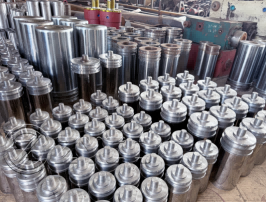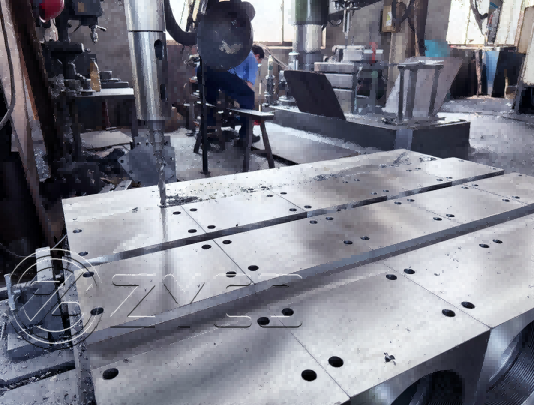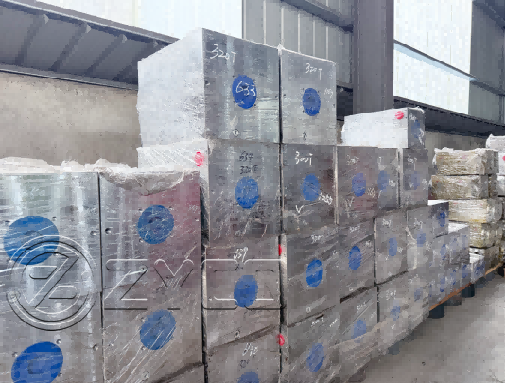In the field of sheet metal processing, bending machines occupy a core position with their powerful forming capabilities. The key core that drives the slider of the bending machine to accurately and powerfully complete each bending action is its "hydraulic cylinder". It is like the "power heart" of the bending machine, converting hydraulic energy into powerful linear mechanical force, which directly determines the performance, accuracy and reliability of the equipment. ZYCO will deeply explore the structure, principle, type and maintenance points of the bending machine cylinder.
Ⅰ. Core structure and working principle
1. Main components:
Cylinder: A solid cubic (internal cylindrical) structure, usually made of high-strength forged steel, with precision machining inside to form a sealed chamber that contains hydraulic oil and pistons, and withstands high pressure.
Piston rod: Usually made of high-strength alloy steel, the surface is precision ground and hard chrome plated to provide excellent wear resistance, rust resistance and low friction surface. It is connected to the piston at one end and extends out of the cylinder to connect the slider at the other end.
Piston: Installed on the piston rod, tightly fits the inner wall of the cylinder. The piston is equipped with sealing rings (such as step seals, Gly rings, O-rings, etc.), which divide the cylinder body into a rodless chamber and a rod chamber to prevent hydraulic oil leakage.
Sealing system: This is the "lifeline" of the cylinder. It includes piston seals (main seals), piston rod seals (dust seals + main rod seals), guide belts (support rings), etc. High-quality seals prevent hydraulic oil from leaking out (leaking) and external contaminants from invading.
End covers: The front and rear end covers seal the cylinder body, usually integrating guide sleeves (guiding and supporting the piston rod) and sealing components. The front cover has holes for the piston rod to extend.
Oil port: Located on the cylinder body or end cover, connected to the hydraulic pipeline, supplying pressure oil to and from the rodless chamber and the rod chamber.

2. Working principle:
Extension (working stroke): Pressure oil enters the "rodless chamber" of the cylinder through the oil port. The hydraulic oil pushes the piston, and the piston drives the piston rod to extend outward. At this time, the oil in the rod chamber is discharged and flows back to the oil tank (or into other cylinders/systems).
Retraction (return): The pressure oil enters the "rod chamber" of the cylinder through the oil port. The hydraulic oil pushes the piston, driving the piston rod to retract into the cylinder. At this time, the oil in the rodless chamber is discharged and flows back to the tank (or into other parts of the system).
The thrust/pull force generated by the cylinder is determined by the hydraulic system pressure (P) and the effective area (A) of the piston (F = P * A). The rodless chamber has a large area, and the thrust force generated (when extending) is much greater than the pull force generated by the rod chamber (when retracting).

Ⅱ. Key types of hydraulic cylinders for bending machines
1. By quantity and synchronization method:
Single cylinder drive: mainly used for small or early bending machines. The structure is relatively simple, but the slider is prone to tilt, affecting the bending accuracy, especially when the table is large.
Double cylinder drive (mainstream): The absolute mainstream configuration of modern bending machines. There is a cylinder on each side to drive both ends of the slider. The core challenge lies in the precise synchronization of the two cylinders to ensure parallel movement of the slider, which is crucial to the bending accuracy. Synchronization is usually achieved through:
Mechanical synchronous shaft (torsion bar): low cost and high reliability, but may produce slight torsional deformation under high speed or high load, affecting the accuracy.
Hydraulic synchronization valve (dividing and collecting valve): The flow of the two cylinders is controlled to be equal through the precision valve body.
Electro-hydraulic servo/proportional synchronous closed-loop control (high-end): Use sensors (grating scale, magnetic scale) to detect the slider position (or the displacement difference between the two cylinders) in real time, and dynamically adjust the flow entering the two cylinders through the servo valve/proportional valve and control system to achieve extremely high-precision synchronization. This is the standard configuration of high-precision bending machines.
2. By the piston rod fixing method:
Piston rod fixed type: The piston rod is fixed at both ends (usually connected to the frame through earrings or spherical bearings), and the cylinder moves (connected to the slider). The structure is compact and suitable for space constraints or specific design requirements.
Cylinder fixed type (most common): The cylinder is fixed on the bending machine frame, and the piston rod moves (connected to the slider). This is the most common structural form, and installation and maintenance are relatively convenient.

3. By installation form:
Flange installation: The cylinder end has a flange and is fixed to the frame with bolts.
Earring installation: The cylinder or end cover has earrings and is fixed by a pin connection.
Tripod installation: The bottom of the cylinder has a mounting foot and is fixed with bolts.
Ⅲ. The influence of cylinder performance on bending machine
Strength and tonnage: The cylinder diameter and system pressure of the cylinder directly determine the nominal pressure (tonnage) of the bending machine.
Speed and efficiency: The response speed and running speed (fast down, working feed, return) of the cylinder affect the bending cycle time and are related to production efficiency. Fast down is often achieved by the weight of the slider or the filling valve.
Precision and stability:
Synchronous accuracy: The level of dual-cylinder synchronous control is the core factor that determines the parallelism of the slider and the consistency of the bending angle of the workpiece.
Rigidity: The rigidity of the cylinder itself and the connecting parts affects the deformation under load, which in turn affects the accuracy.
Low-speed stability: In the working feed stage of precision bending or thick plate bending, it is crucial whether the cylinder can run smoothly and without creeping at low speed.
Reliability and life The manufacturing quality (material, processing accuracy), seal performance and maintenance status of the cylinder determine the trouble-free operation time and overall service life of the equipment.
Ⅳ. Common faults and maintenance points of hydraulic cylinders of bending machines
Common faults:
External leakage: Piston rod seal wear and aging, end cover seal damage, and loose joints. It is the most common problem, resulting in oil contamination and insufficient pressure.
Internal leakage: Piston seal wear or damage, resulting in oil leakage in the rodless cavity and the rod cavity, manifested as insufficient thrust, slider sinking (unable to maintain pressure), and slow speed.
Slow/weak movement: Severe internal leakage, insufficient system pressure, improper oil viscosity or contamination blockage, and oil cylinder leakage.
Creeping (shaking): Air mixed in the cylinder (need to be exhausted), piston rod bending or poor guide, too tight seal or poor lubrication, oil contamination.
Abnormal sound: Loose internal parts, serious wear of guide belt, bending or straining of piston rod, and air mixing.
Asynchronous (dual cylinder): Synchronous valve/system failure, sensor failure, loose mechanical connection, and serious single cylinder leakage.
Maintenance points:
1. Keep the hydraulic oil clean: Regularly replace the filter element to prevent pollutants (dust, metal chips, moisture) from entering the system. This is the key to protecting seals and precision mating surfaces.
2. Regularly check the oil level and oil quality: Ensure that the oil volume is sufficient and the oil is not emulsified, discolored, or over-oxidized.
3. Clean the piston rod: After each work or before the shift, clean the exposed piston rod surface with a clean soft cloth to remove dust, oil, and metal powder to prevent it from being pulled into the seal ring and causing wear and leakage. It is absolutely forbidden to use cleaning tools with hard particles!
4. Check for leaks: Regularly inspect all parts of the cylinder (piston rod, end cover, joint) to promptly detect and deal with leaks.
5. Tighten the connectors: Check and ensure that the cylinder mounting bolts and pipe joints are tightened reliably.
6. Avoid overloading and eccentric loading: Strictly operate according to the rated tonnage of the equipment, try to make the bending force act on the center area of the slider, and avoid extreme eccentric loading to damage the cylinder and the fuselage.
7. Regular professional maintenance: Perform comprehensive hydraulic system maintenance in accordance with manufacturer requirements, including checking the condition of seals (replace if necessary), system bleeding, etc.
Conclusion
Although the hydraulic cylinder of the bending machine is not conspicuous, it is the cornerstone of the power and precision of the equipment. In-depth understanding of its structure, principle and key performance, and implementation of scientific maintenance can effectively improve the processing accuracy and production efficiency of the bending machine, significantly extend the service life of the equipment, and reduce the losses caused by downtime. For operators and maintenance personnel, paying attention to this "power heart" is the fundamental way to ensure the long-term stable and efficient operation of the bending machine. In the era of pursuing higher precision and more intelligent bending processing, the hydraulic cylinder and its synchronous control technology are still evolving, providing a stronger core driving force for the metal forming industry. As a sheet metal machinery manufacturer, ZYCO has in-depth research in the field of hydraulic cylinders for bending machines. If you have any questions, please feel free to contact us.
Leave your email address and requirements, our professional sales team will develop the most suitable solution for you.
Copyright © 2025 Nanjing Zyco Cnc Machinery Co., Ltd. All Rights Reserved.
 Network Supported
Network Supported